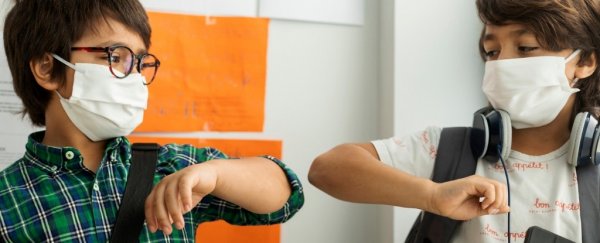Summer in the Northern Hemisphere is coming to an end, and if we're not super careful about reopening our schools and daycare centres, experts warn children could soon play a much bigger role in the pandemic.
Just because kids often don't show symptoms, doesn't mean they don't carry any traces of the virus, new research has shown.
While children might contract COVID-19 at lower rates to adults and show milder or no symptoms, once they do catch the virus, scientists say they may carry unusually high loads of it.
This means even without any obvious symptoms, kids with COVID-19 are potentially contagious, carrying a high number of viral particles from school to home and back again.
"During this COVID-19 pandemic, we have mainly screened symptomatic subjects, so we have reached the erroneous conclusion that the vast majority of people infected are adults," says pediatric gastroenterologist Alessio Fasano who works at MassGeneral Hospital for Children in Boston.
"However, our results show that kids are not protected against this virus. We should not discount children as potential spreaders for this virus."
The study, which was conducted at two hospitals in Boston during the peak of an outbreak, is said to be the most comprehensive analysis of pediatric COVID-19 patients to date.
Among 192 children and young people between the ages of 0 and 22, the authors found 49 kids who were carrying SARS-CoV-2 (the coronavirus that causes COVID-19) and 18 kids who had multisystem inflammatory syndrome in children (MIS-C) - an ailment related to COVID-19.
Compared to adults hospitalised for COVID-19, these children had surprisingly higher levels of coronavirus in their airways, especially in the first two days of contracting it.
"I was not expecting the viral load to be so high," admits pediatric pulmonologist Lael Yonker from Massachusetts General Hospital.
"You think of a hospital, and of all of the precautions taken to treat severely ill adults, but the viral loads of these hospitalised patients are significantly lower than a 'healthy child' who is walking around with a high SARS-CoV-2 viral load."
That's a disturbing result, because having a higher viral load could potentially mean more shedding of the virus and, therefore, a greater risk of contagion. While this study did not examine transmissibility of the virus directly, the findings do suggest children may be a hidden source of spread.
While other studies have found kids show fewer immune receptors for SARS-CoV-2 than adults, the new research suggests this has little impact on the actual presence of the virus.
Instead, it seems even when children show mild or no symptoms, they are, in fact, carrying high doses of the virus, enough to hospitalise an adult.
"Pediatric patients displayed no apparent difference in viral load compared with adults requiring intubation for severe SARS-CoV-2 infection when stratified by time. Viral load in children in the symptomatic/early infection phase was significantly higher than in hospitalised adults with severe disease with over 7 days of symptoms," the team writes in the study.
Some initial research on adults suggests higher viral loads are linked to more severe outcomes, but for some reason, this doesn't appear to be the case in children.
In the end, the authors say this could make infection-control strategies much harder to implement, especially since mild symptoms of COVID-19 appear so similar to other common illnesses.
"Identifying SARS-CoV-2 infection in children will become even more challenging during pollen allergy season and influenza season this fall," the authors write.
While fever is usually the first symptom of COVID-19, the study found only half the children with acute SARS-CoV-2 infections presented with a high body temperature.
This suggests temperature screening may not be an effective tool in reopening schools and daycare centres. Instead, the authors suggest focusing on strategies like social distancing, mask use, viral screening, and/or remote learning.
"Without infection control measures such as these," the authors conclude, "there is significant risk that the pandemic will persist, and children could carry the virus into the home, exposing adults who are at higher risk of developing severe disease."
In communities of lower income, where multiple generations often live under the same roof, this could very well be deadly.
In the study, nearly 20 percent of acute SARS-CoV-2 infections and those with MIS-C did not have a known household exposure to the virus.
It's not clear how this infection spreads through a house or a school, but recent research suggests it might have to do with the age of the child. Children under 10, for instance, do not seem to spread the virus as far as their older counterparts.
"This study provides much-needed facts for policymakers to make the best decisions possible for schools, daycare centers and other institutions that serve children," Fasano says.
"Kids are a possible source of spreading this virus, and this should be taken into account in the planning stages for reopening schools."
Fasano is worried about what will happen if schools reopen fully.
The study was published in the Journal of Pediatrics.
